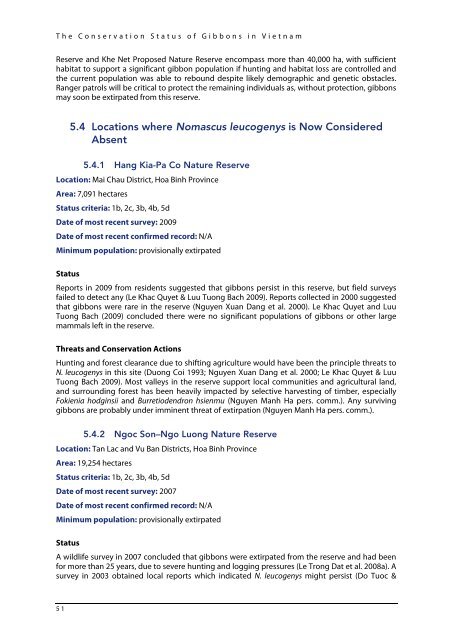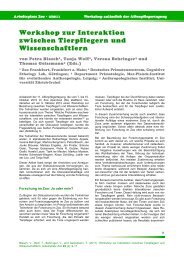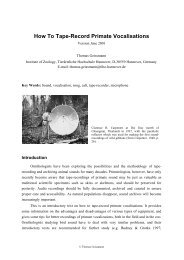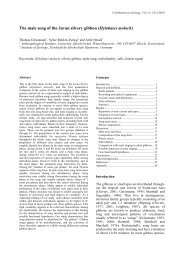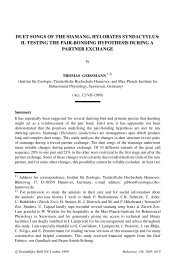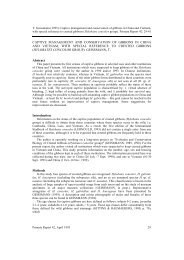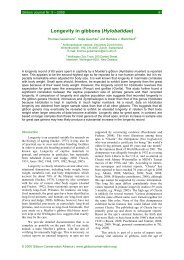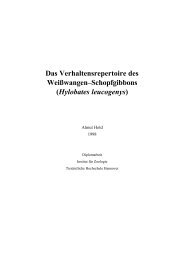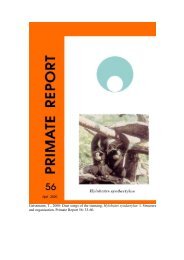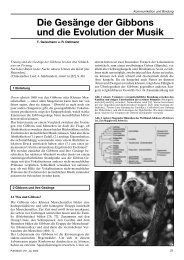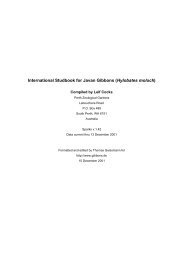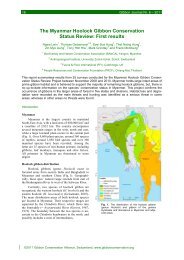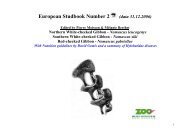The Conservation Status of Gibbons in Vietnam - Gibbon Research ...
The Conservation Status of Gibbons in Vietnam - Gibbon Research ...
The Conservation Status of Gibbons in Vietnam - Gibbon Research ...
Create successful ePaper yourself
Turn your PDF publications into a flip-book with our unique Google optimized e-Paper software.
<strong>The</strong> <strong>Conservation</strong> <strong>Status</strong> <strong>of</strong> <strong><strong>Gibbon</strong>s</strong> <strong>in</strong> <strong>Vietnam</strong>Reserve and Khe Net Proposed Nature Reserve encompass more than 40,000 ha, with sufficienthabitat to support a significant gibbon population if hunt<strong>in</strong>g and habitat loss are controlled andthe current population was able to rebound despite likely demographic and genetic obstacles.Ranger patrols will be critical to protect the rema<strong>in</strong><strong>in</strong>g <strong>in</strong>dividuals as, without protection, gibbonsmay soon be extirpated from this reserve.5.4 Locations where Nomascus leucogenys is Now ConsideredAbsent5.4.1 Hang Kia-Pa Co Nature ReserveLocation: Mai Chau District, Hoa B<strong>in</strong>h Prov<strong>in</strong>ceArea: 7,091 hectares<strong>Status</strong> criteria: 1b, 2c, 3b, 4b, 5dDate <strong>of</strong> most recent survey: 2009Date <strong>of</strong> most recent confirmed record: N/AM<strong>in</strong>imum population: provisionally extirpated<strong>Status</strong>Reports <strong>in</strong> 2009 from residents suggested that gibbons persist <strong>in</strong> this reserve, but field surveysfailed to detect any (Le Khac Quyet & Luu Tuong Bach 2009). Reports collected <strong>in</strong> 2000 suggestedthat gibbons were rare <strong>in</strong> the reserve (Nguyen Xuan Dang et al. 2000). Le Khac Quyet and LuuTuong Bach (2009) concluded there were no significant populations <strong>of</strong> gibbons or other largemammals left <strong>in</strong> the reserve.Threats and <strong>Conservation</strong> ActionsHunt<strong>in</strong>g and forest clearance due to shift<strong>in</strong>g agriculture would have been the pr<strong>in</strong>ciple threats toN. leucogenys <strong>in</strong> this site (Duong Coi 1993; Nguyen Xuan Dang et al. 2000; Le Khac Quyet & LuuTuong Bach 2009). Most valleys <strong>in</strong> the reserve support local communities and agricultural land,and surround<strong>in</strong>g forest has been heavily impacted by selective harvest<strong>in</strong>g <strong>of</strong> timber, especiallyFokienia hodg<strong>in</strong>sii and Burretiodendron hsienmu (Nguyen Manh Ha pers. comm.). Any surviv<strong>in</strong>ggibbons are probably under imm<strong>in</strong>ent threat <strong>of</strong> extirpation (Nguyen Manh Ha pers. comm.).5.4.2 Ngoc Son–Ngo Luong Nature ReserveLocation: Tan Lac and Vu Ban Districts, Hoa B<strong>in</strong>h Prov<strong>in</strong>ceArea: 19,254 hectares<strong>Status</strong> criteria: 1b, 2c, 3b, 4b, 5dDate <strong>of</strong> most recent survey: 2007Date <strong>of</strong> most recent confirmed record: N/AM<strong>in</strong>imum population: provisionally extirpated<strong>Status</strong>A wildlife survey <strong>in</strong> 2007 concluded that gibbons were extirpated from the reserve and had beenfor more than 25 years, due to severe hunt<strong>in</strong>g and logg<strong>in</strong>g pressures (Le Trong Dat et al. 2008a). Asurvey <strong>in</strong> 2003 obta<strong>in</strong>ed local reports which <strong>in</strong>dicated N. leucogenys might persist (Do Tuoc &51


